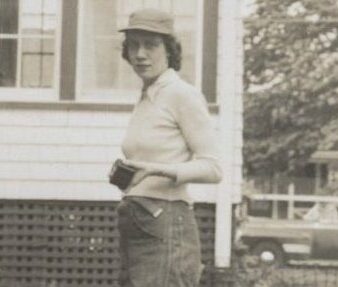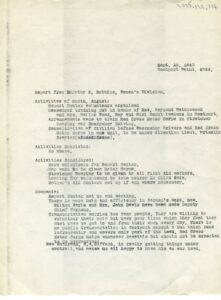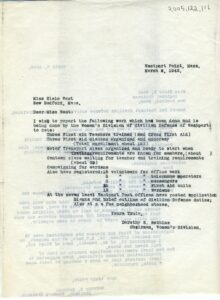Dorothy Robbins Curtis (1910-2008)
Posted on March 1, 2024 by Jenny ONeill

WOMEN OF WESTPORT POINT
DOROTHY ROBBINS CURTIS
Artist, writer, historian
1813 Main Road, Westport Point
“The written word can last longer and provide present and future generations with knowledge of the town – not like an old history book with dates, places and names strung together in a dull melange. Such things are often essential, but I feel history should develop the human side.” (Dorothy Curtis)
Dorothy Robbins Gifford Curtis was born in Boston, but spent most of her life in Westport. She married two Westport men: Norman Gifford and Mahlon Curtis. Her parents were Charles M. Robbins and Minnie Swint Robbins who moved to Westport and proceeded to buy land in 1924. Plan Book 25, p 1919 which he divided up into small lots. The roads Lawrence Avenue, Chester Avenue, Fairview Avenue, and Charles and Robbins Street remain from that subdivision. Minnie’s homestead in 1940 is shown in Plan Book 33, page 20. It extended from Charles Street 300 ft to the south at Main Road and about 350 feet to the West. When Dorothy died she owned only part of that property.
She attended Southern Seminary in Virginia and graduated from Westport, High School, Bradford Junior College, and Pratt Institute School of Fine and Applied arts in Brooklyn, NY, majoring in textile design. She also studied art independently with Tseng Hsien-Chi, Stephen Olszewski, Herbert Hadfield, Dennis Broadbent and Alden Wicks.
For most of her life Mrs. Curtis was an artist, doing textile design in New York, interior decorating in Florida and with the C. F. Wing Co., in New Bedford, MA.
During WWII she served as a draftsman with the Army Corps of Engineers in Providence, RI, a driver for the Women’s Army Corps and an airplane spotter. After the war she worked as an advertising artist with the Christian Science Monitor, owner of one handicraft shop and manager of another. She also assisted her mother in running a successful gift shop and tea room at their home at 1813 Main Road.

Mrs. Curtis retired from commercial work and turned to freelance landscape and floral painting, for which she received several awards. She was a frequent contributor to WGBH Channel 2 art auctions. Her artwork has been shown in exhibitions in Florida, New York and southeastern New England. Her paintings are in many private collections throughout the United States.
Mrs. Curtis was also a published writer and award-winning poet. She wrote The Chimney Cupboard, a weekly column in the Westport News for about three years, as well as occasional articles for the New Bedford Standard-Times, the Dartmouth (MA) Chronicle, the Westport Shorelines and the Westport News. She participated actively in the Seniors Writing Seminar sponsored by the Westport Council on Aging.
She was a founder, past president and some say the spirit of the Westport Art Group. The Art Group honored Mrs. Curtis by presenting a one-artist show of her paintings in 2006. She was also an active member of the Westport Historical Society and a former member of the Providence Watercolor Society, Newport Art Association and Museum, Fall River Art Association, Whaling Museum of New Bedford, Westport River Watershed Alliance and the Order of the Eastern Star. She was a member of the First Church of Christ, Scientist Congregations in New Bedford and Boston. Her other interests included gardening, dancing, water sports and music. She was an active member of Norma Judson’s Westport History Group. There are a number of videos of Dorothy at the Westport Historical Society.
Primitive Living at the Point by Dorothy Curtis
Modern living came gradually to Westport Point. The “good old days” were not really easy for many who lived in the country. They stayed either because they inherited a house and land, or because they liked fresh air and the quiet of the country. Sometimes it was just from habit, staying where they had spent most or all of their lives.
When we moved to the “Point” in 1923, some houses down the street had electricity and some did not. Ours was one of the latter, like all others up our way.
Our water came from a well just outside the back door. It was deep for a dug well – about twenty-five feet – and was on the porch, which had a wooden floor and a roof. That made it less of a chore to get water, especially in bad weather. Depending on how one felt about it at the time, getting a bucket of water might be a pleasant diversion, or just one more bit of work to be done.
Now visitors from a city frequently ask “What’s that?” about our well curb and well. A well curb is a wooden housing on top of and surrounding the well. So for the uninitiated and/or nostalgic, here’s how it worked: A long rope was tied to the handle of a wooden bucket with two leather valves over the two holes in the bottom, allowing the water to flow in. Then the weight of the water kept the valves closed while the bucket was drawn up by a crank on the side of the well curb. For safety’s sake, the crank had to be turned by a firm hand to let the bucket down.
Otherwise, if left to itself after the lock was released, it would go down very fast, cracking the well curb, or worse, injuring an arm held too close. Upon the bucket’s return, a small lip or hook at the edge of the bucket caught on a bar going across the front inside of the curb. This tipped the bucket and the water flowed out through a sort of funnel and into a pail set under it. All wells were similar, only some let down by hands holding firmly to a rope.
I’ve learned that not all well water tastes the same. Each time we had ours checked, it was clean, healthy and tasted so good! When the full pail was carried into the house and set on the counter next to the kitchen sink, there was always a dipper close by to take out water for a drink, washing, cooking and so on. It wasn’t really hard work, although each step was a little harder than the one before it. Carrying a full pail and trying not to spill any water was the hardest, especially inside the kitchen.
Since the only indoor plumbing was a kitchen sink with a drain to let out the water, we had to patronize the outhouse, or privy. It was modestly set behind what may once have been a woodshed but was a garage for longer than we had lived there. Our privy was three-holed, three sizes – for papa, mama, and baby. Every morning, potties were emptied into a slop pail, which was carried to the backhouse. Daytime trips out there weren’t too bad, except in winter when it was cold and drafty. Evening trips required a lantern or flashlight, and the hope that nobody would meet a skunk!
There were also indoor routines to be tended to. Before dark, the kerosene lamps had to be filled wicks trimmed and the outsides wiped clean. A small lamp or candle showed the way to bed.
Cooking was done on a kerosene-fed stove with three or four burners and a temperamental oven.
For room heat, we first had an old coal furnace and noisy steam radiators. My father got rid of all that and had a one-pipe furnace – now known as a floor furnace – installed with a big register in the dining room, the center of the house. He liked to stand over it and feel the heat coming up around him. He still had to shovel coal and get rid of occasional coal gas, which was unpleasant and very unhealthy.
After about two years of persuasion – talking to neighbors, the electric company in New Bedford and even Mayor Ashley in that busy little city – my father succeeded in getting an electric line brought up to our part of the village. What a relief! We had electric lights at last.
He even had a light put in the outhouse. Andrew Taber, a carpenter and neighbor, was quite impressed when he looked in it one day and commented, “I’ve seen quite a lot of outhouses, but I’ve never seen one with electricity before!”
After the lights, plumbing fixtures were installed, but the whole job was not yet completed. We still had to carry water. We were told that our well was too deep for a shallow well pump and not deep enough for a deep well pump. So we waited, wondering what to do.
My father died, and I went off to college. A few months later I received a letter from my mother saying she’d had a pump put down the well and now there was running water, both hot and cold.
That news was so exciting that I went home for the weekend to see the water come out of the faucets! I was so thankful, especially for my mother, that living would be easier there. No longer would she have to haul in a pail of water to wash anything – hands, dishes, clothes – or heat the required amount on the stove. No more lugging in two or three pails to flush the toilet. There was also plenty of water for a bath. We felt quite civilized then. It was wonderful!

